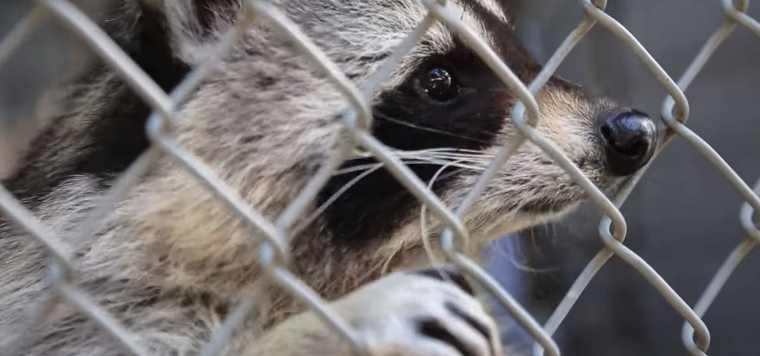-
info@aaanimalcontrol.com
Call us for help in your town
Humane Wildlife Education
Raccoon information
Need raccoon removal in your hometown? We service over 500 USA locations! Click here to hire us in your town and check prices- updated for year 2020.
Most of us already know what a raccoon looks like — it's about the same size as your average house cat, has a masked-looking face, and is a combination of grey, black, brown, and white tones. They aren't born with these markings and colorings; however, and are fuzzy and light-colored at birth, and thy are both blind and deaf. It won't be until the kits are about three to four weeks old that they will be able to start seeing and hearing for the first time, and, at the same age, they will also have started to grow some fur. Their stomach regions are essentially bald for the first few weeks of their lives.

Six Weeks Old
At about six weeks of age, a raccoon youngster will be about ready to start eating solid foods and may venture outside of the den a little to find adventure and something to snack on, such as insects or small morsels of food that have been left around.
A female raccoon can have as many as five to seven kits in one litter, meaning that she will have her hands full. Her pregnancy usually lasts for around eight to ten weeks. If any of her youngsters become sick or suffer an injury and are, therefore, less likely to stay alive than their stronger and more able peers, there is a chance that she may abandon the runt of the litter. This is actually quite a common practice in the animal world.
Two Months Old
For the first two months or so, the kits won't venture off too far. The den offers safety and protection from predators that are just lurking in the shadows and waiting for an easy snack. Until they reach this age, raccoon babies aren't ready for the outside world, and may not have fully developed all running, climbing, and perhaps even fighting skills that they would need to stay alive.
Three Months Old
At three months of age, the mother will have taught her young just about enough for them to be able to start hunting for their own food, but they still won't venture too far from her safe watch.
One Year Old
For the first year or so of their lives, she will be aggressively protective of her youngsters, doing everything that she needs to do in order to keep them alive. Sadly, it is fairly common for over half of the kits born in a litter to die before they reach six months old. This will be for a number of reasons, including human intervention, household pets, other wild animals and predatory attacks, vehicle collisions, poisoning, starvations, disease, and more.
Females are known to stay with their mothers for longer than the males do, and the females are also more likely to live together as a group, especially when they then go on to have their children. There is safety in numbers — other mothers will be able to keep an eye on the babies when that babies mother has gone out to find food. In some cases, females will also share their food stashes with other females.
Males are much more eager to venture out and explore the world, get into fights with other males in a bid to win and exert territories and boundaries, and find lots of females to mate with. They are the more solitary of the two sexes, although it is not uncommon to find males and females living together quite happily in dens during cold and severe winter seasons.
Dens
Raccoon dens can be found in a number of places, both in urban and rural habitats. These creatures refer to live close to water, and it will almost always be in an area that also contains lots of trees. In fact, trees make the perfect nesting spots for these critters, particularly in tree hollows and on large enough and stable branches.
When trees aren't available, the den can be found closer to the ground, in wood piles, rock formations, and even underground. Residential and commercial properties will also be hit, in areas such as under porches, balconies and decking, and also in basements, attics, outbuildings, sheds, etc.
Diet
Raccoons are classed as scavengers and opportunistic hunters/feeders. This means that they will pretty much anything and everything that just so happens to look like food. This might include dead carcasses by the side of the road — animals that have been killed as a result of vehicle collisions, or food that is easy to find in your back yard — fruit or berries going on shrubs and trees, as well as various other forms of plant life, vegetable patches, bird feeders, garbage bags, compost heaps, cat or dog food bowls, farm feed, leftover scraps of food on the BBQ, and a whole load more besides.
Raccoons will eat both animal and plant matter, and even food that we deem unsuitable to eat, such as food that has gone bad. If you leave food lying around in your back yard, be prepared for a small, furry and masked little visitor!
For more information, you may want to click on one of these guides that I wrote:
How much does raccoon removal cost? - get the lowdown on prices.
How to get rid of raccoons - my main raccoon removal info guide.
Example raccoon trapping photographs - get do-it-yourself ideas.
Raccoon job blog - learn from great examples of raccoon jobs I've done.
Raccoons in the attic - what to do to solve the problem.


















